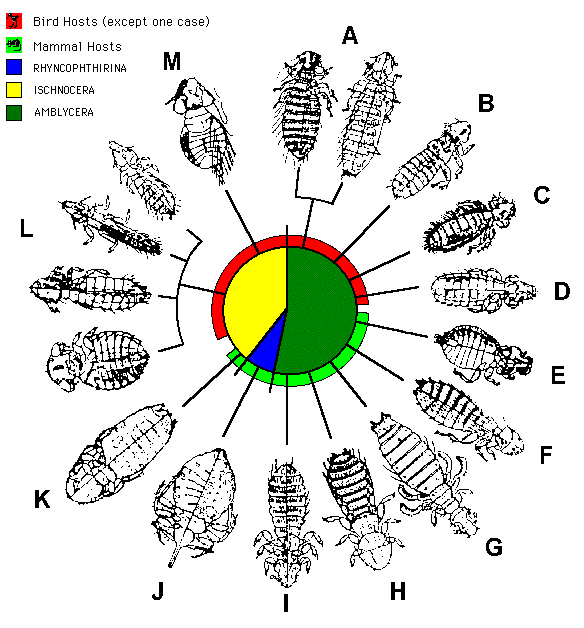The "Mallophaga" are a paraphyletic grouping comprising all lice other
than the Anoplura. The diagram below displays the range of morphologies
of various families of "Mallophaga."
Click on a louse to see which family it belongs to:

|
Amblycera
A: Menoponidae (all orders of birds, includes the Trinotonidae)Click on an image to view larger version & data in a new windowB: Trinotonidae (most spp.- Ducks, geese and swans)
Click on an image to view larger version & data in a new windowC: Laemobothriidae (rails, storks, hawks)
Click on an image to view larger version & data in a new windowD: Ricinidae (small passerines, including the Trochiliphagidae of hummingbirds)
Click on an image to view larger version & data in a new windowE: Trochiliphagidae (hummingbirds)
Click on an image to view larger version & data in a new windowF: Boopiidae (most spp.- Australian marsupials)
Click on an image to view larger version & data in a new windowG: Gyropidae (cavimorph rodents)
Click on an image to view larger version & data in a new windowH: Trimenoponidae (neotropical marsupials & cavimorph rodents)
Click on an image to view larger version & data in a new windowI: Abrocomophagidae (a single species from a rodent)
Click on an image to view larger version & data in a new window
Rhyncophthirina
J: Haematomyzidae (elephants and wart-hogs)Click on an image to view larger version & data in a new window
Ischnocera
K: Trichodectidae (mammals)Click on an image to view larger version & data in a new windowL: Philopteridae (all bird orders)
Click on an image to view larger version & data in a new windowM: Heptapsogasteridae (Tinamiform birds)
Click on an image to view larger version & data in a new window
Title Illustration
Morphologies of various Mallophagan families.
Original drawing modified from Lakshminarayana, K. V. (1986). "Data book for the study of chewing lice (Phthiraptera : Insecta)." Records of the Zoological Survey of India: Miscellaneous Publication, Occasional Paper No. 81: 1-63.; modified by R.D.M. Page, 1997).
Note that this diagram is intended to illustrate the morphological diversity of the "mallophaga" and should not be interpreted as a classification scheme for chewing lice. I am currently preparing a generic phylogeny for the Ischnocera however no such scheme exists for the Amblycera to date.
Picture copyright © 1997, R.D.M. Page.




 Go to quick links
Go to quick search
Go to navigation for this section of the ToL site
Go to detailed links for the ToL site
Go to quick links
Go to quick search
Go to navigation for this section of the ToL site
Go to detailed links for the ToL site